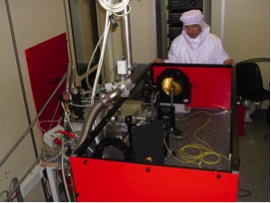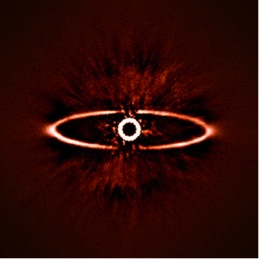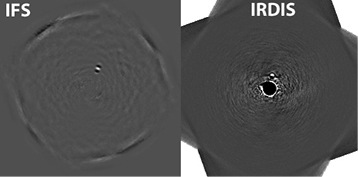
The SPHERE instrument, soon after its installation on the third 8-m telescope of ESO’s VLT. Credits ESO/J.-L. Beuzit et al.
Out of the thousand or so exoplanets known to date, only a handful were found by direct imagery using the radiation that these hot bodies (1000-1500 K) emit. This was, in particular, the case for the giant planet beta Pictoris b or the system of giant planets orbiting the star HR8799.
The main objective of the SPHERE instrument is to detect (out to 300 light years) and to characterize, using direct imagery, giant exoplanets around stars in the solar neighbourhood (closer than 100 parsec).
This constitutes a considerable challenge, since such planets are close to their parent stars,
and their luminosity is much weaker.
As a rough analogy, using SPHERE, one could detect from Paris the light of a candle just 50 cm from a light-house in Marseille.
In practise, SPHERE will be able to detect the signal of a planet which is a million times dimmer than its parent star, which thus corresponds to an order of magnitude improvement over existing instruments. This means that, instead of being limited to finding planets which are 5 to 10 times the mass of Jupiter, the case to-day, we will be able to observe Jovian mass planets.
On a normal image, obtained even in the best possible conditions, the stellar light completely obliterates the dim planetary radiation. SPHERE has thus been designed specifically to enhance as much as possible the contrast in the immediate neighbourhood of the star.
A « second generation » instrument
SPHERE is a second generation instrument, which combines a very advanced system for correcting atmospheric turbulence, (using adaptive optics), with coronagraphs to block out the light of the central star, and modules for detailed analysis of the light.
Its highly advanced adaptive optics system uses a deformable mirror with over 1300 actuators which correct for atmospheric turbulence over nanometric scales at over 1200 times per second.
Its coronagraphic masks block out the light of the central star.
Three light detecting modules involve imagery, spectroscopy and diffferential polarimetry, in both the visible and near infra-red domains.
Technical participation of the Observatoire de Paris
The Laboratoire d’Etudes Spatiales et d’Instrumentation en Astrophysique (LESIA) of the Observatoire de Paris has participated in the SPHERE project at various levels.
The LESIA, responsible for the coronagraphic modes, has provided the coronagphic components which were made on site and at the Observatoire de la Côte d’Azur.
It has concentrated on the development of an achromatic phase coronagraph (HW4QPM) which attenuates the light of the central star while enabling the observation of very close planets.
Following figures show the coronagraphic component and its test bench at the Observatoire de Paris in Meudon.


The LESIA has also participated in the development of :
- the tip/tilt mirrors of the instrument, based on original concepts of the Observatory
- an infra-red wave front detector, which enables the coronagraph to be pointed at the star with a 0.5 milliarcsecond precision
- the adaptive optics real time computer
- the integration tests of the adaptive optics system, which took place in the clean room of the Paris Observatory at Meudon
- numerical simulations of the instrument : these helped define the specifications of certain components (the quality of certain optical components) and to predict their performance .

Promising results
During the first real sky tests, many astrophysically interesting objects were observed in order to validate the various operating modes of SPHERE. The results include one of the best images ever obtained for the dust ring around the star HR 4796A, which could be surrounding planets (still to be detected).

The ring is exceptionally well resolved. This image is also witness to the remarkable capacity of SPHERE to cut out the light of the bright star in the centre of the image, while correcting for the effects of atmospheric turbulence. Analysis of this kind of picture will yield information about how planets form in other planetary systems.
The exceptional performance of SPHERE is also highlighted by the image of the star iota Sagittarii around which orbits a companion star (a small not very massive star) which has been observed for the first time ever. The instrument will again undergo a series of intensive test during 2014 to finish the validation of all its operating modes, and so put it at the disposal of the scientific community at the beginning of 2015. A massive survey, lasting 5 years, will then begin to search for new planetary systems. SPHERE could also study the atmospheres of these newly discovered giant planets, and the properties of the dust discs within which exoplanets are formed.

SPHERE’s first light, at the beginning of mai 2014, has also validated the stellar coronagraph.
The following figure shows the sky image of a single star. On the left hand side image, obtained without the coronagraph, one can see only the star ; on the right hand side image, obtained using the coronagaph, a large fraction (80 à 90%) of the stellar light has been eliminated – the background of this latter image obtained with adaptive optics, has low level structures, within which could be hidden exoplanets ; a seach for these requires specialized image analysis


The instrument will be at the disposal of the scientific community from 2015.
European consortium of laboratories
SPHERE was developed by a European consortium led by the Institute for Planetology at Grenoble (IPAG, CNRS/Université Joseph Fourier) together with the ONERA, the Laboratoire d’Astrophysique de Marseille (CNRS/AMU), the Laboratoire d’Etudes Spatiales et d’Instrumentation en Astrophysique (Observatoire de Paris/CNRS/UPMC/Université Paris Diderot), the Laboratoire Lagrange (Observatoire dela Côte d’Azur/CNRS/Nice-Sophia Antipolis University) as well as German, Italian, Swiss and Dutch laboratories, together with ESO (European Southern Observatory).
